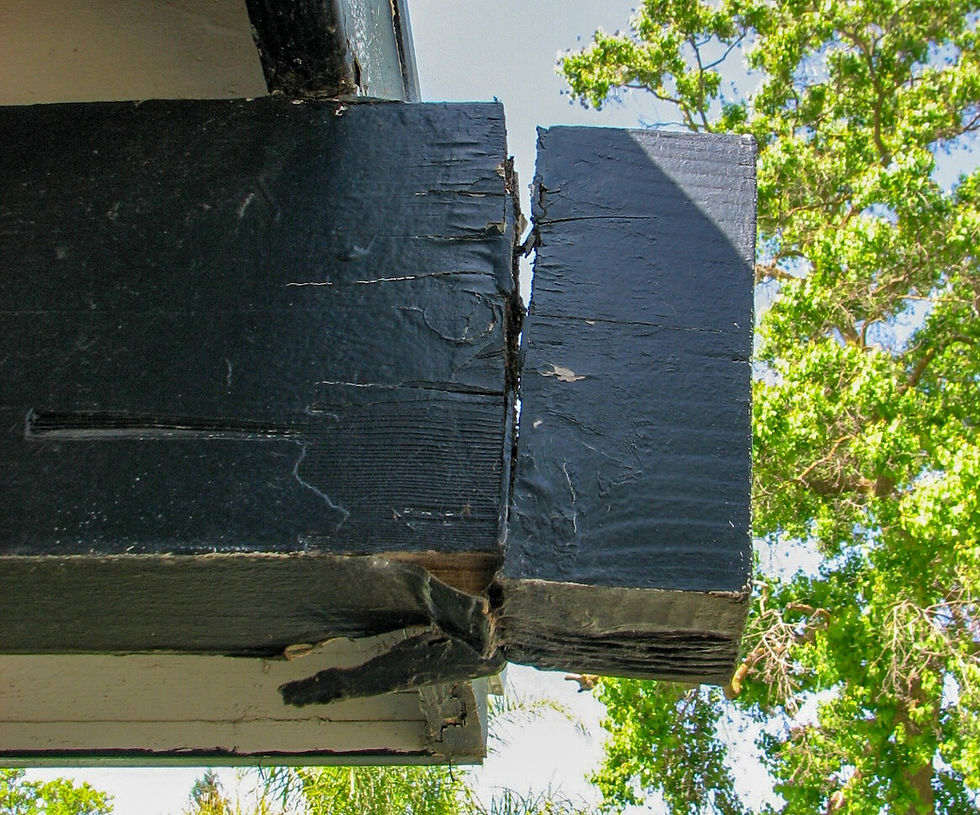Exterior Beam Repair
- The Beam Guy

- Sep 18, 2021
- 4 min read
Updated: Jan 28
What Not To Do, or
NO! You Can't Just Stick A New Block On It . . .
Beam repair isn't as simple as one might expect. Choosing the the wrong beam repair can lead to more dry rot and ongoing damage to your home.
It's important to remember that dry rot damage is the result of a water dependent fungus; no water = no dry rot fungus. Any of the commonly available lumber from the average big box store will slowly dry and shrink. The only question is one of degree. Eventually, the new block will, at the very least, shrink away from the joint. It may even end up smaller than the original beam it's spliced onto. Any gap, no matter how small, is a channel for water to feed dry rot fungi.
The following is a brief overview of failed splice joints used in an attempt to repair and/or restore exterior roof beams.
Not With Dowels and Glue . . .
This dry rot repair was so weak that it came apart in my hand. It may have looked great when it was originally done, but the dry rot repair of a roof beam cannot be only about looks. The additional cost of needing a second repair only adds to the problem.

Not With Nails and Bolts . . .
This dry rot repair will eventually be a headache for the homeowner — possibly in more ways than one. At least the cost of the rework will be less painful than being struck in the head when this block ultimately falls.

Not With Screws . . .
An entire box of screws could have been used on this roof beam dry rot repair and the results would have been just as disappointing. Hiding decay behind a block is a lot like hiding the truth; in the end, it's only going to make things worse.

Not Even At An Angle . . .
It really wouldn't matter what the cut-angle was on this exterior beam repair, the outcome would still be the same, -- dry rot. With this configuration, the rainwater shedding from the roof will channel directly into the joint between the roof beam and the block that was meant to repair it. This, unfortunately, amounts to roof beam failure on the installment plan — again.

Not With Nails And A Lag Bolt And At An Angle . . .
This angle cut to the exterior beam necessitated the addition of multiple types of fasteners to support the weight of the added block. The lag bolt transected an existing dry rot vein. This (poorly patched) vein remained a water access to continue feeding the dry rot fungi.

Not With THREE Lag Bolts From Below . . .
When a wood beam end is cut off and a new block is spliced onto the remaining original exterior beam, fasteners secure the splice. Yes, this lag bolt method is a great way to secure a heavy beam end, but it does nothing to solve the original problem -- dry rot. As the new piece dries and shrinks, leaving the cut in the original exterior beam exposed, the dry rot fungi has yet another access to water. Besides, that open joint looks simply awful.

Not With Stepped Cuts And Glue And Screws And Bondo And Paint . . .
This exterior beam repair was attempted with a stepped block and a layer of a wood bondo to cover over the joint before painting. I'm sure the smooth appearance was beautiful while it lasted. However, it did nothing to address the dry rot or to prevent rainwater from continuing to channel in.

The results of this beam repair method are revealed by the removal of the splice block. Now, both the added block and the original beam have dry rot and voids affecting the structural integrity, as well as creating an open supply line of water for the dry rot fungus.

Below is the amount of the original exterior beam that was too damaged by dry rot to be saved. If it was not cut away it would have eventually collapsed -- possibly taking some of the roof framing with it. With this much damage, the only option was to use my Century Beam repair (How-to book currently being written).

Beam Repair?
Each of the photos on this page were dry rot "repairs." Look carefully at the images and you will clearly see, in all but one, that not only do the spliced pieces have dry rot, the original exterior beam continued rotting back in towards the house. The poorly done roof beam repair was in fact only causing more damage, which of course led to an additional and more costly beam repair.
No matter how an exposed roof beam end is repaired, it must be done in such a way as to channel rainwater away. Water is the lifeblood of the dry rot fungus that creates roof beam decay. A well-conceived roof beam repair begins with this in mind. A wood roof beam restoration that takes on water is destined for the same fate as a wood boat that does; each is sure to leave you with a sinking feeling...
To see the results of more bad ideas for beam repair, go to Insufficient Repairs.
To learn more about epoxy and other wood fillers in beam repair, Beam Repair Products.
To learn more about dry rot in beams, go to The Nature of Beam Dry Rot.




Comments